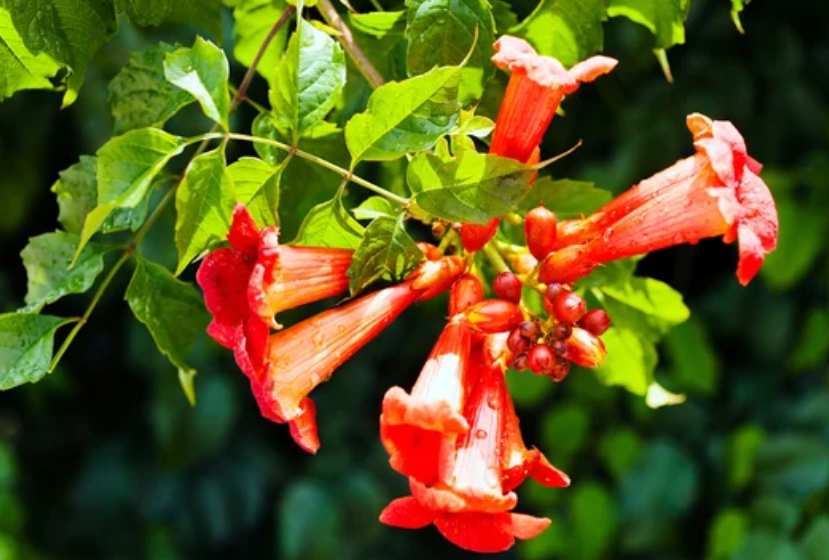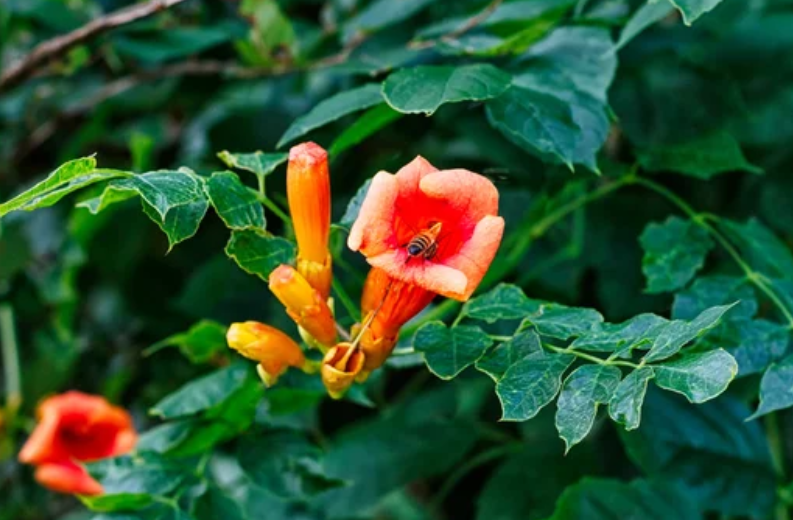
What are trumpet vines, and what makes them unique?
Trumpet vines are flowering plants that belong to the Bignoniaceae family. What makes them unique is their showy, trumpet-shaped flowers that attract hummingbirds and butterflies.
They are fast-growing, low-maintenance plants that can add color to any garden or landscape.
Trumpet vines require full sun and well-drained soil. They are low-maintenance plants, but regular pruning is necessary to control their growth and prevent them from becoming invasive. Additionally, they should be watered regularly, especially during dry spells, to keep the soil moist.
Trumpet vines are a beautiful addition to any garden, with their vibrant and colorful blooms that attract Ruby-throated hummingbirds and butterflies. However, caring for these plants can be tricky if you don’t know what you’re doing.
We will cover everything you need about trumpet vine care, from understanding the essential growing conditions to pruning techniques for beautiful blooms. Also, choosing suitable soil and water for your plant for optimal growth and the importance of light and temperature in trumpet vine care.
Additionally, we will detail how to propagate your plant and overwinter it to protect it from harsh weather conditions. Lastly, we will address common problems you may encounter with your trumpet vine, including Neglect, and provide solutions.
Understanding Trumpet Vine Care
Trumpet vine (Campsis radicans) is a vigorous perennial vine that produces clusters of bright orange, red, or yellow flowers that attract hummingbirds. However, it can also cause skin irritation, be invasive, and damage structures if not appropriately controlled.
To grow and care for trumpet vine, you must provide sturdy support, such as a fence, wall, or trellis, and prune it regularly to keep it in bounds. You must also remove unwanted shoots and seed pods to prevent them from spreading.
Aerial rootlets can help the trumpet vine climb and adhere to its support structure, making it a great addition to any garden or landscape with trellises.
Trumpet or Hummingbird vine prefers full sun and average, well-drained soil. It does not need much fertilizer or water but can tolerate drought and poor soil conditions.
Choosing the Right Soil for Trumpet Vines
The ideal soil type is crucial for Gardeners to ensure that their trumpet vines thrive and establish a solid foundation. When choosing soil for trumpet vines, consider key factors that optimize their growth and ensure long-term health.
Trumpet vines, also known by their Common name, prefer well-draining soil with a pH between 6 and 7.5. They can tolerate various soil types, including loam, sandy, or clay soils, as long as they are enriched with organic matter. These vines are native to the eastern united states and are known for their beautiful trumpet-shaped flowers.
Providing suitable soil conditions with the right flava will help your trumpet vines flourish and produce clusters of the best flowering trumpet-shaped flowers. Remember to avoid using the primary keyword at the beginning of the content.
How to Water Trumpet Vines for Optimal Growth
To water trumpet vines for optimal growth, you need to follow these steps:
- Water the plants deeply and thoroughly once a week, from spring to fall, during the growing season. Avoid frequent shallow watering, which can encourage shallow roots and fungal diseases.
- Check the soil moisture before watering by inserting your finger into the soil up to the second knuckle. If the ground feels dry, it’s time to water. If the soil feels moist or wet, wait until it dries out.
- Apply a layer of mulch around the base of the plants to help retain soil moisture and prevent weeds. Use organic wood chips, pine needles, or shredded leaves. Keep the mulch a few inches away from the stems to avoid rotting.
- Reduce watering in winter, when the plants are dormant. Water only when the soil is arid and the plants show signs of wilting. Do not water if the temperature is below freezing or if there is snow or ice on the ground.
The Importance of Light and Temperature in Trumpet Vine Care
The trumpet vine (Campsis radicans), also known as the Trumpet creeper, is a deciduous woody vine that produces clusters of bright, trumpet-shaped flowers in summer and fall. It can grow up to 40 feet tall and is hardy in USDA zones 4 to 9.
However, to keep this plant healthy and blooming, providing it with the right light and temperature conditions is essential.
Light
The trumpet vine prefers full sun, meaning at least six hours of direct sunlight daily. Or Partial shade during autumn. This ensures that the plant produces enough energy for growth and flowering. If the plant receives less light, it may become leggy, weak, and prone to pests and diseases. It may also produce fewer or no flowers at all.
Temperature
The trumpet vine can tolerate a wide range of temperatures, from -30°F to 110°F. However, it performs best in Humid climates, where it can multiply and flower profusely. In colder regions, the plant may die back to the ground in winter but will resprout in spring.
To protect the roots from freezing and erosion, it is advisable to mulch the base of the plant with organic matter, such as leaves or straw. Alternatively, the plant can be grown in a container and moved indoors during winter. Groundcover can also be a protective layer to keep the soil warm and prevent frost damage.
Fertilizing Trumpet Vines: What You Need to Know
One way to control the growth and flowering of trumpet vines is to fertilize them properly. , which can also benefit pollinator gardens.
Here are some tips on how to fertilize trumpet vines:
- Fertilize trumpet vines only if they show slow growth or poor flowering. Too much fertilizer can encourage excessive foliage growth and reduce flowering.
- Use a balanced fertilizer, such as 10-10-10, and apply it around the vine’s root zone. Avoid getting fertilizer on the leaves or stems, which can cause burning.
- Apply fertilizer in early spring, before the flower buds form, or about two weeks after the last frost. Do not fertilize during the summer or fall, as this can stimulate new growth vulnerable to frost damage.
- Apply fertilizer sparingly, using no more than two tablespoons (30 ml) per plant. Overfertilizing can prevent flowering and make the vine more invasive.
- Prune back trumpet vines in late winter or early spring to keep them in shape and promote flowering. Cut the vines to 12 to 24 inches (31 to 61 cm) above the ground. This will encourage new growth from the base of the plant and more flowers during the summer.

Pruning Techniques for Beautiful Trumpet Vine Blooms
Pruning trumpet vine is essential to keep it under control and to encourage new growth and flower production. Trumpet vines bloom on new wood, so pruning them in late winter or early spring before they leaf out is best.
You can also prune them lightly throughout the growing season to shape and remove dead or damaged branches. Pruning trumpet vine too hard or too late can reduce the number of blooms and delay their appearance.
Here are a few tips on how to prune trumpet vine effectively:
- Use sharp and clean pruning tools to avoid spreading diseases or damaging the plant.
- Cut back the main stems to about 3 to 4 feet from the ground, leaving at least two or three buds on each branch.
- Remove any suckers that emerge from the base of the plant or the roots, as they can become invasive and compete with the main vine.
- Thin out crowded or crossing branches to improve air circulation and light penetration.
- Trim back any lateral shoots that grow beyond the desired size or shape of the plant, leaving a few inches of growth for flowering.
- Apply a balanced fertilizer after pruning to promote healthy growth and blooming.
Propagating Trumpet Vines: A Step-by-Step Guide
Propagating trumpet vines is a rewarding and easy way to add more color and fragrance to your garden. Trumpet vines are fast-growing, hardy plants that produce clusters of trumpet-shaped flowers in shades of red, orange, yellow, or pink. They also attract hummingbirds and butterflies with their nectar.
Here are 8 steps to propagate trumpet vines from cuttings:
1. Choose a healthy stem that has at least three sets of leaves and no flowers or buds. Cut off a 6-inch section from the tip of the branch with a sharp knife or pruning shears. Remove the lower leaves and any side shoots, leaving only the top two or three leaves.
2. Dip the cut end of the stem in rooting hormone powder, shaking off any excess. This will help the cutting form roots faster and prevent rotting.
3. Fill a small pot with moist potting mix and make a hole in the center with your finger or a pencil. Insert the cutting into the hole, burying about half of the stem. Firm the soil around the cutting and water well.
4. Cover the pot with a clear plastic bag or a glass jar to create a mini greenhouse. This will keep the cutting humid and warm, which are ideal conditions for rooting. Place the pot in a bright spot, but avoid direct sunlight, which can scorch the cutting.
5. Check the cutting every few days and mist it with water if the soil feels dry. Occasionally, You can open the plastic bag or jar to let some fresh air in and prevent fungal growth.
6. After four to six weeks, you should see new growth on the cutting, indicating that it has rooted. You can test this by gently tugging on the stem; if it resists, it has roots. Remove the plastic bag or jar, continue to water, and care for the cutting until it is ready to transplant.
7. Transplant the cutting into a larger pot or directly into the garden in spring or fall when the weather is mild. Choose a sunny location with well-drained soil and plenty of space for the vine to grow. Trumpet vines can reach up to 30 feet in height and spread by underground runners, so they may need pruning and containment to prevent them from taking over.
8. Enjoy your new trumpet vine and watch it bloom from summer to fall!

Overwintering Trumpet Vines: Protecting Your Plant
Trumpet vines are hardy plants that can survive cold winters, but they may need some extra protection in areas where the temperature drops below -20°F. Here are some tips on overwintering your trumpet vines and keeping them healthy for the next growing season.
- Prune your trumpet vines in late fall or early winter after the leaves have dropped. Cut back any dead, diseased, or damaged branches, and remove any suckers growing from the base of the plant. Leave about 6 to 8 inches of healthy growth above the ground.
- Mulch your trumpet vines with thick organic material like straw, leaves, pine needles, or wood chips. This will help insulate the roots and prevent them from freezing. Cover the entire root zone with at least 4 inches of mulch, and extend it a few inches beyond the plant’s drip line.
- Wrap your trumpet vines with burlap or a frost cloth if you live in a freezing climate or if your plants are exposed to harsh winds. This will protect the stems and buds from frost damage and desiccation. Secure the wrapping with twine or clips, but do not tightly tie it around the plant.
- Remove the mulch and wrapping in early spring, when the danger of frost has passed. Check your trumpet vines for signs of new growth, and prune any branches that did not survive the winter. Water your plants well and fertilize them with a balanced fertilizer to encourage blooming.
How to Encourage Blooming in Trumpet Vines?
To encourage blooming in trumpet vines, you need to provide them with enough sun, water, and pruning.
Sunlight is essential for trumpet vines to produce flowers. They need at least six hours of direct sun daily, preferably more. If your trumpet vine is planted in a shady area, you may need to move it to a sunnier spot or trim any nearby trees or shrubs that block the light.
Watering is also essential for trumpet vines, especially during hot and dry weather. Depending on the soil moisture and rainfall, they should be watered every week or two. Avoid overwatering or underwatering; both can stress the plant and reduce flowering.
Pruning is the key to controlling the growth and spread of trumpet vines. They can grow up to 40 feet long and send out suckers and runners that can invade other areas of your garden or damage structures.
Pruning also stimulates new growth and flowering. It would help to prune your trumpet vine in winter or early spring before the new development starts. Cut back any dead, damaged, or unwanted stems to the ground or a main branch. Leave some healthy stems with buds for flowering.
By following these tips, you can enjoy the beauty of trumpet vines without letting them take over your garden. Trumpet vines are rewarding plants that can add color and life to your landscape.
Common Problems and Solutions in Trumpet Vine Care
Uncontrollable spread
Trumpet vine can grow up to 40 feet long and spread through underground runners and seeds. It can damage buildings, walls, foundations, and other plants if not controlled. To prevent this, plant trumpet vine at least 6 to 12 feet away from structures or trees and prune it regularly to keep it in bounds.
You can also remove the seed pods before they mature and dispose of them properly. Alternatively, you can grow trumpet vine in a large container with drainage holes and place it on a sturdy trellis or arbor.
Powdery mildew
This fungal disease causes white to gray powdery patches on the leaves. It can reduce the vigor and flowering of the plant. To prevent powdery mildew, provide good air circulation around the plant, avoid overhead watering, and keep the plant healthy. If you notice any infected leaves, remove them and destroy them. You can also apply a fungicide if the infection is severe.
Leaf spot
This is another fungal disease that causes tiny holes in the leaves. It is usually not a serious problem but can affect the plant’s appearance. To prevent leaf spots, follow the same steps as for powdery mildew. You can also use a fungicide if needed.
Conclusion
To ensure beautiful trumpet vine blooms, providing the right growing conditions, soil, water, light, and temperature is essential. Pruning techniques and propagating methods also play a role in maintaining healthy vines. Additionally, protecting the plant during winter and encouraging blooming are crucial steps.
While caring for trumpet vines, it’s essential to be aware of common problems and have solutions. By following these tips and techniques, you can enjoy the vibrant and stunning blooms of trumpet vines in your garden.
Remember to be patient and consistent in your care routine, and soon you’ll be rewarded with a flourishing trumpet vine that adds beauty and charm to your outdoor space.






















